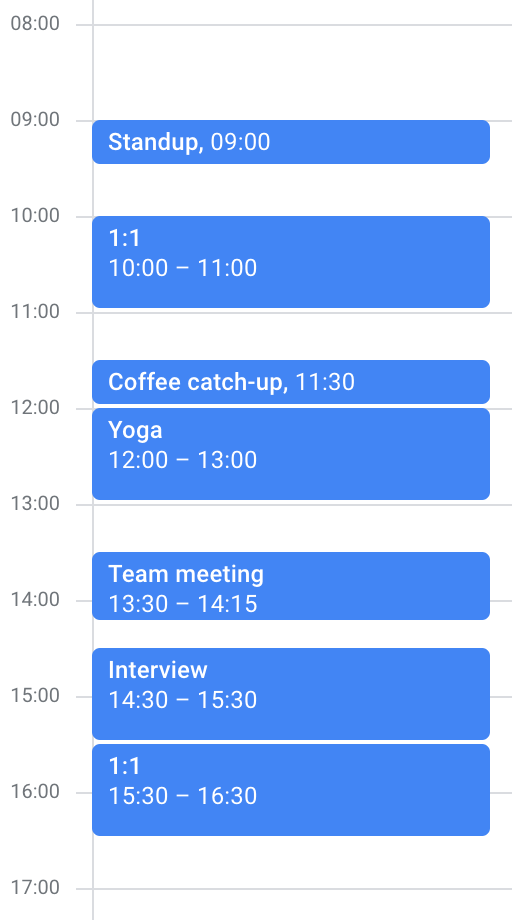One of the best things I ever did for my productivity was to re-think the way I manage my daily schedule, especially when it comes to meetings. Prior to that, I never had any meaningful time for deep work that required intense thought.
Now, a few years on, my colleagues suspect I figured out a magic formula that adds extra hours to the day. In reality, it’s more alchemy than sorcery. Like turning lead (a calendar overrun with meetings) into gold (a schedule neatly organized into blocks).
At the risk of spoiling the surprise, this is roughly how my days flow:
Morning – drop kids off at school, commute, and pack in my meetings with US-based people.
Lunchtime – yoga or meditation, as well as scarfing down some lunch.
Afternoons – deep work on projects, etc., then take meetings with Sydney-based people.
Evenings – family time (though exactly when “evening” starts varies by day, as you’ll see below).
Looks simple and easy – like, “Geez, Alastair, what’s so special about that?” But the simple elegant finished product is the result of a whole lot of sausage-making.
You have to spend time to make time
Newsflash: if you want your schedule to work for you, you need to devote time to organising and maintaining it on a regular basis. Before we dive into the nitty-gritty mechanics of rearranging your calendar, here’s what you should mentally prepare for:
- Initial organisation. The first time around, expect to take 1-3 hours getting fully organised, depending on the number of recurring meetings you attend.
- Weekly maintenance. Block out 30 minutes on Friday afternoon to review your calendar for the following week. If you have clashes, reorganise them. Yes, more clashes may come up during the following week but at least you will start the week with a clear, clash-free calendar.
- Ongoing maintenance. Once every quarter or so, you will likely need to spend 1-3 hours to review and reorganise your meetings. Recurring meetings will drop off, new ones will appear, and you’ll need to reshuffle things.
Regular maintenance is critical for maintaining calendar sanity. Remember, it’s an investment – not a tax.
Categorise how you intend to use your time each day
Does your calendar typically look like this? Random meetings stretched out across the day with little 15-30 minute gaps interspersed everywhere? There’s no time for any kind of real work, which is incredibly frustrating.
If you want to create blocks reserved for deeper work, you need to organise your days into categories of work. First, decide whether you’ll be better off doing your deep work in the mornings or afternoons and note everything you’ll need to reschedule to accommodate that. More time for deep work is the whole point of de-fragging your calendar, so stake your claim by putting in those deep work blocks, then try to make everything else fit around it.
Next up: recurring tasks or activities that absolutely have to happen at certain times. Do you need to drop kids off in the morning? Or leave by a certain time? What about that standing appointment with your chiropractor? Mark those on your calendar so you don’t end up with clashes.
Last, tackle your meetings. If you have a bunch of 1-on-1 meetings you need to run each week, group them together and run them back to back. Then work through other meetings you own.
If you regularly work with teams in different time zones, make sure you schedule meetings thoughtfully. For example, I’m based in the US but work with teams in Sydney a lot. So I always book meetings with my local colleagues in the morning before the cross-over time with Sydney kicks in. This way, I have a fighting chance at getting in all my interactions with those teams without having to stay late. (Though it still happens – more on that below.)
Ideally, you’ll end up with blocks of meetings grouped together instead of scattered throughout your day. Do be self-aware, though: if you’re the sort of person who simply can’t take more than two meetings in a row, honor that.
Choose the hours you’ll work each day
Working in a geographically dispersed company managing teams across many timezones, I have made peace with the fact that I will need to work late or come in early on specific days. I stay later on Tuesdays and Thursdays to take meetings with my Sydney teams. On those days I will come into the office slightly later and take my kids to school.
For many people, working hours will be determined for them by the company. But if you have flexibility, be proactive about scheduling your hours for each day.
Spell out your schedule explicitly
Maybe you’ve already tried the thing where you block off 2 hours on your calendar and label it something like “Blocked: deep work time”. I used to do that. And you know what I did during those times? Not work. I would catch up on Slack channels, browse our company intranet, or engage in similarly undisciplined and unproductive activities.
I find it far more effective to put a block on my calendar that shows my colleagues (and more importantly, me!) exactly what I’ll be working on and for how long. In your Friday afternoon “weekly maintenance” mentioned above, create blocks for the top three things you need to accomplish the following week. Not only does this help you hold yourself accountable to your own plans, but others will also be less likely to book a meeting over clearly labeled block than if it was just a generic “work time” slot.
You can even set up your focus blocks to recur at the same times every week so things are consistent for you and your co-workers. Then, with the space already held, all you need to do on Fridays is update the timeslots on your calendar to show what you’ll be working on.
Over time I have come to schedule pretty much everything into my calendar. The eagle-eyed amongst you will notice my calendar entries for commuting, picking up kids, yoga, and meditation. I even send calendar events to my wife so she knows when I’m planning to work late. No harm in putting household events like school holidays and dentist appointments on both partners’ calendars too, for that matter.
Being clear with your blocked time sends a signal to others that the time is well and truly spoken for, and they’re not to schedule over it. Plus it helps you maintain focus. If an activity or task wasn’t important enough to be scheduled, perhaps it’s not adding value to your day.
And did you notice my use of color? It’s not just because I’m a designer! Color is a great visual cue for understanding your own calendar at a glance. I use red for events that are really important and shouldn’t be moved unless absolutely necessary. Yellow items need to happen but could be rescheduled if needed. Green blocks are my deep work time, and purple indicates personal items – both of which can flex. Other people use one color for meetings, another color for deep work blocks, and a third color for personal items.
Common scheduling obstacles and how to overcome them
“But I don’t own all the meetings on my calendar.” This one is hard, especially for bigger team meetings. You need to talk to the meeting owner and try to work out another time. Most people will understand what you’re trying to accomplish and will do their best to accommodate. Moving meetings around does take time, though. No two ways about it.
“The new time for this meeting works for everyone… except the meeting room.”Do a fully remote meeting, even if you all have desks in the same office. Since starting to work with the Trello team (60% of whom work remotely full-time), I’m come to embrace their tradition of all-remote meetings. It removes the find-a-room and puts everyone in the group on equal footing – nobody has to be the one remote attendee struggling to hear and be heard. Ask your attendees to find a private booth, book their own room, or don their headphones and join from their desk.
“I can’t seem to clear away all the clashes in my schedule.” Accept that you’ll have to make hard choices sometimes as you prioritise which meetings you’ll attend and where you make space for deep work. A few things to keep in mind:
- Don’t cancel the same meeting too often.
- Be respectful with 1-on-1 meetings as they are very important for your team. Try not to cancel these at all.
- Be polite and give as much notice as possible when you decline a meeting invite.
- Many problems can be worked through asynchronously via Confluence, Google Docs, or Slack.
Et voilà!
This is how I’ve crafted a daily schedule that allows for deep work and helps keep me in love with my job. Your mileage may vary. Ultimately, managing your calendar is an exercise in personal preferences. So take control and create a schedule that works for you – not the other way around.
. . .
Feelin’ that love/hate relationship with meetings? Us too. Check out our collection of articles that’ll show you how to avoid the unnecessary ones and make the most of the ones you actually need.












































